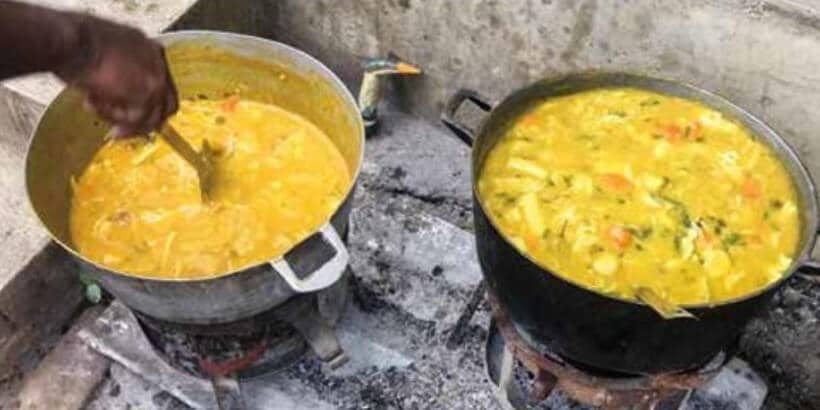RECIPE: Soup of Independence and Remembrance

For most people, traditional foods and family recipes are often thought of in the simple terms of comfort foods or those dishes that only make an appearance at the holidays. However, for many, traditional foods are so much more than that. They are a gateway to health and wellness and offer an opportunity to reflect on the lives of the ancestors who passed before us. But what happens when access to those traditional foods is lost? And how can we reclaim them in order to replenish our bodies and souls?
The following is an excerpt from Farming While Black by Lean Penniman. It has been adapted for the web.
Traditional African diets are inherently healthy and sustainable, based in leafy greens, vegetables, fruits, tubers, and legumes. Communities that maintain our traditional diets have much lower rates of heart disease, high blood pressure, stroke, diabetes, cancer, asthma, glaucoma, kidney disease, low-birthweight babies, obesity, and depression. When our ancestors, survivors of the Middle Passage, first reached plantation America, they attempted to continue their traditional diets, growing and preparing boiled yams, eddoes (or taros), okra, callaloo, and plantain, which they seasoned generously with cayenne pepper and salt.
Under enslavement and colonization, their diets began to shift and their health began to deteriorate. On meager rations of corn and the offcuts of pork, and with little time to grow vegetables, our enslaved ancestors suffered from deficiencies in protein, thiamine, niacin, calcium, magnesium, and vitamin D. As a result of poor diet and living conditions, half of the infant children of enslaved mothers died before their first birthday, twice the mortality rate of white children. Children who survived often suffered from night blindness, abdominal swellings, swollen muscles, bowed legs, skin lesions, and convulsions from chronic undernourishment.
It is imperative that we decolonize our diets and reclaim African traditional foodways. Disease and early death are not part of our ancestral heritage. From the Black American South to the Caribbean, from South America to West Africa, there are commonalities in the traditional diet. We base our meals on leafy greens, vegetables, and tubers enlivened with ample herbs, spices, and sauces. We consume fresh fruits often and only make decadent desserts for special occasions. We use fish and meat in small quantities, usually to flavor a stew, and only eat meat in quantity on celebration days.
Dairy is rare in our cuisine, and when we do consume it, we first ferment the milk into yogurt or buttermilk. Most important, we cook and eat together. In Kroboland, Ghana, whenever a person is eating and someone passes by, the person says, “Ba eh no” (come and eat). Our tables are healing tables, fellowship tables, and living history tables. We offer our gratitude to the Oldways Preservation Trust for creating the African Heritage Diet Pyramid to uplift our healthy, traditional ways of eating.
Soup Joumou
Soup Joumou is the soup of Independence, the soup of remembrance, and the soup that celebrates the New Year. The soul-warming dish commemorates January 1, 1804, the date of Haiti’s liberation from France. The soup was once a delicacy reserved for white enslavers but forbidden to the enslaved people who cooked it. After Independence, Haitians took to eating it to celebrate the world’s first and only successful revolution of enslaved people resulting in an independent nation.
Active time: 30 minutes
Total time: 1 hour, 15 minutes
Yield: 6–8 servings
Ingredients
1 pound (0.5 kg) Kabocha squash or Caribbean pumpkin, peeled and chopped
Oil (canola, safflower, or sunflower)
4 cloves garlic, crushed
1 celery stalk, chopped
1 large onion, chopped
2 potatoes, chopped
½ pound (0.25 kg) cabbage, chopped
1 turnip, diced
2 carrots, chopped
2 leeks or scallions, chopped
1 can (12 ounces/360 ml) whole coconut milk
8 cups (2 L) water
1 cup sweet corn, fresh or canned
1 tablespoon chopped parsley
1 whole Scotch bonnet pepper or other spicy pepper
1 tablespoon lime juice
2 whole cloves
Salt
Pepper
Thyme
Splash of sweetener (optional)
8 ounces (226 g) pasta (optional)
Procedure
- Coat the squash/pumpkin in oil and roast until golden brown and tender. Simultaneously, in a separate pan, roast the remaining vegetables (except the corn, parsley, and hot pepper) in oil and a bit of salt until golden and tender.
- Blend the cooked squash with the coconut milk in a blender or food processor, then add this to the water in a medium stockpot and bring to a low boil.
- Stir in the roasted vegetables and the corn, parsley, and hot pepper.
- Add spices to taste.
- Cook for 15 to 20 minutes to blend the flavors. If you are using pasta, add it when there are 10 remaining minutes of cook time.
Note: The squash and hot peppers are essential ingredients. All other ingredients can be replaced with similar vegetables that are locally available.
Recommended Reads
Recent Articles
The Garlic Clove! This small crop adds a big punch of flavor that complements almost every delicious dish you could think of. And the best part? These two recipes are a breeze to make together!
Read MoreOur love affair with amaranth began long before the pseudo-grain became a trendy staple for gluten-free folk. The luscious leaves of this annual plant are not only packed with a plethora of health benefits.
Read MoreDon’t know where to start for foraging wild plants? Read on for the information you need to begin foraging on your own: where to do it and how to be safe.
Read MoreEasy rainbow coleslaw! Transform your salad game with this colorful recipe. It is surprisingly packed with flavor and is a great addition to your repertoire.
Read MoreIf you love tomatoes, you probably already know just how many varieties of these summertime staples there are. But do you know what makes each one unique?
Read More









